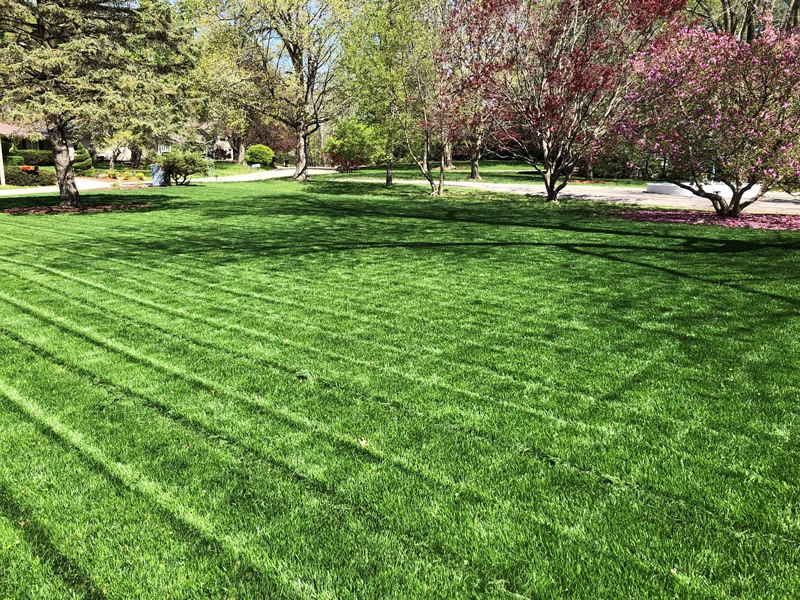Issue 1, April 29, 2019
Mowing the Lawn
When it comes to lawn care, mowing is a fundamental aspect of lawn maintenance. If done incorrectly, the cut will result in a thin, weak, weed infested lawn that will continue to be a problem that cannot be corrected by mowing alone. However, if properly mowed, the lawn will be uniform, dense and attractive. There are four elements to mowing that should be considered: cutting heights, mowing frequency, mowing pattern, and disposal of clippings.

1. Selecting the cut
A cutting height refers to the length of grass above the soil. When selecting the height, a few things must be considered. A slight shift in height can be disastrous depending on the species and timing. A grasses leaf is responsible for making photosynthesis, so removing a large portion of the leaf results in reduced carbohydrate production. Reduced carbohydrates will weaken the turf and allow it to be invaded by weeds and or injured by disease, insects or environmental stress. The loss of the leaf will also cause a severe reduction in root, rhizome and stolon growth. Therefore, a cutting height should be selected for overall health and vigor as well as visual aesthetics.
Individual species and cultivars vary in required cutting height for the best overall performance. Do not underestimate the importance of cutting height specifications, even though the difference may be only a half inch. For example, tall fescue will be seriously thinned by continued mowing below one and one-half inches, whereas cutting creeping bentgrass above an inch may cause a heavy thatch leaving it with a conducive environment for diseases. Turf density and quality can be improved by raising the cutting height in the shaded areas. This increases the leaf area for capture of the limited light energy.
Turf will also benefit from raising the height during and immediately after (a) midsummer heat stress on cool season turf, (b) turf that has been weakened by pest injury, traffic or other environmental stress. A slightly higher cutting height may be used during the seedling establishment so that the plant can focus on root development.
2. Mowing frequency
When and how often you mow the turf is just as important as selecting the right cutting height. The general rule of thumb is to remove no more than 1/3 of the leaf at any one mowing.
Removing more than 1/3 of the leaf causes a severe shock to the plant, and frequently results in partial loss of the root system, plus exhaustion of the carbohydrate reserves that leads to a slow recovery. A failure to mow frequently enough causes excessive leaf removal which can seriously damage the root system and lower lawn’s vigor
Mowing frequency can vary seasonally, depending on the rate of leaf growth. Turf should be mowed more often as the leaf growth rate increases or as the cutting height is lowered. When there are favorable conditions, such as favorable temperatures, light and moisture conditions as well as high nitrogen levels the leaf blades grow quickly. For cool season grasses – the growth is optimum from 60-70 degrees, and for warm-season grasses from 80-95 degrees. With favorable conditions, a typical frequency of mowing will be 6-8 days for an average lawn.
3. Mowing pattern
A mowing pattern should be considered even though it is not as critical as the height or the frequency. In successive mowing, try varying the pattern in 2 or 3 directions. This will distribute traffic and wear more uniformly over the turf area and improve the quality of the cut.
A side by side mowing pattern is acceptable, particularly if the 360 turns can be made on sidewalks or roadways rather than on the edge of the turf. If the turf is thinning due to about face turns, try a circular cut starting at the perimeter and working towards the center of the lawn. When mowing on a steep slope, mow across and not up or down. This will help to prevent the slope to tear away over time.
4. Disposal of clippings
When it comes to grass clippings, unless there are big piles of grass left after mowing, clippings do not need to be collected. Small clippings readily decompose (contain 75 - 80 percent water) and do not cause thatch. Clippings provide organic matter, and plant nutrients, in particular nitrogen, phosphorous and potassium, so less fertilizer is needed. Mulching mowers are not really necessary. A study at the University of Illinois showed mulching mowers did not provide any additional benefit over conventional rotary mowers returning clippings, assuming proper mowing frequency and lawn fertilizing was followed.
Sources
https://web.extension.illinois.edu/cfiv/homeowners/070802.html
How to have a Beautiful Lawn by Dr. James Beard
Author:
Maria Turner